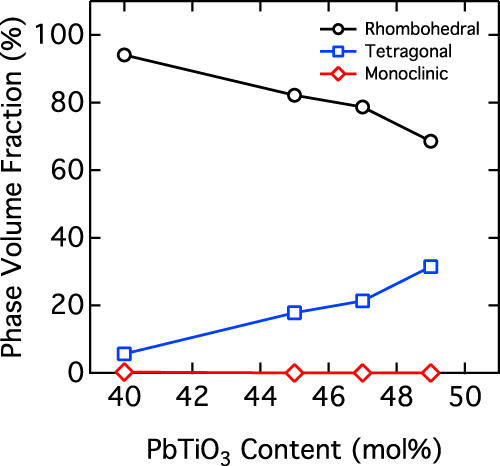Abstract
The strain- and polarization-electric field behavior was characterized at room temperature for Pb0.98Ba0.01(Zr1−xTix)0.98Nb0.02O3, 0.40 x 0.60. The investigated compositions were located in the vicinity of the morphotropic phase boundary, giving insight into the influence of crystal structure on the hysteretic ferroelectric behavior. The remanent strain of particular compositions is shown to be larger than theoretically allowed by ferroelectric switching alone, indicating the presence of additional remanent strain mechanisms. A phenomenological free energy analysis was used to simulate the effect of an applied electric field on the initial equilibrium phase. It is shown that electric-field-induced phase transitions in polycrystalline ferroelectrics can account for the experimental observations. The experimental and simulation results are contrasted to neutron diffraction measurements performed on representative compositions in the virgin and remanent states.
Introduction
Ferroelectric materials with a perovskite crystal structure are used in a number of technologically important applications, such as actuators in diesel fuel injection systems [Citation1] and transducers in high bandwidth sonar systems [Citation2]. The most commercially important material is polycrystalline lead zirconate titanate Pb(Zr1−xTix)O3, due to its excellent, tunable electromechanical behavior that is stable over a relatively large temperature range [Citation3]. Because of its importance, there have been numerous experimental investigations into the electrical [Citation4], mechanical [Citation5] and electromechanical [Citation6] properties of Pb(Zr1−xTix)O3 as a function of, for example, temperature, composition and loading conditions. Generally, the maximum performance in terms of piezoelectric coefficient and electromechanical strain are found in compositions near the morphotropic phase boundary (MPB), which is the compositional boundary separating the ferroelectric rhombohedral phase (high temperature R3m or low temperature R3c) [Citation7] from the ferroelectric tetragonal phase (P4mm) in the composition–temperature phase diagram [Citation3]. This has led to an intense debate surrounding the nature of the MPB and its influence on the electromechanical properties of Pb(Zr1−xTix)O3 [Citation8–Citation11]. Structural investigations have shown the presence of an intermediate monoclinic phase (space group Cm) at the MPB, which bridges the tetragonal and rhombohedral phases [Citation12, Citation13] in addition to nanodomain formation [Citation10, Citation14]. Using a thermodynamic analysis, Heitmann and Rossetti [Citation15] were able to show that the vanishing polarization anisotropy at a MPB can account for the drastic reduction in the ferroelectric domain size as well as the observed dipole glass state associated with an intermediate ferroelectric phase.
During large signal electrical loading Pb(Zr1−xTix)O3 displays a well-known nonlinear hysteretic behavior that is due to the nucleation and growth of ferroelectric/ferroelastic domains [Citation16]. The ferroelectric constitutive behavior depends on the grain size, temperature, applied mechanical load, dopants and loading frequency, among others [Citation4, Citation10, Citation17–Citation19]. Of particular importance is the composition [Citation6]. At the MPB there is a minimum in the coercive field and a maximum in the obtainable strain [Citation4, Citation20]. As the composition moves away from the MPB toward either the PbZrO3 or the PbTiO3 side of the phase diagram, a corresponding increase in the coercive field and a decrease in the electromechanical strain are observed [Citation21]. In the tetragonal phase this effect has been attributed to the increase in the spontaneous strain with increasing PbTiO3 content, which is proposed to increase the energy threshold for ferroelectric and ferroelastic domain switching [Citation4, Citation22]. Interestingly, a similar increase in the coercive stress was found on the PbZrO3-rich side of the MPB, where a significant change in lattice distortion with decreasing PbTiO3 content is not observed. Here, despite the relative compositional independence of the spontaneous polarization and spontaneous strain, the energy to ferroelectrically or ferroelastically switch a rhombohedral domain increases with decreasing PbTiO3 content. In the vicinity of a MPB, however, previous work has shown using a 2–4–6 Landau potential that the equilibrium free energy flattens [Citation15], which is expected to reduce the energetic barriers to both ferroelectricity/ferroelasticity and field-induced phase transitions. In addition, although the lattice distortion affects the observed domain switching energy barrier, phase stability at the MPB also contributes to the observed macroscopic behavior; it is improbable that ferroelectric switching alone can entirely explain the observed electromechanical strain near the MPB.
A recent investigation by the authors of the present work on the compositionally dependent mechanical properties of co-doped Pb(Zr1−xTix)O3 has revealed that the observed remanent strain in rhombohedral Pb(Zr1−xTix)O3 compositions is significantly larger than theoretically possible during ferroelastic switching [Citation22]. Following the work of Bell [Citation23, Citation24] and Franzbach et al [Citation25] a thermodynamic analysis was presented, which suggested that stress-induced phase transitions could be responsible for the observed behavior. Similar observations of the stress-dependent shift in phase of perovskite ferroelectrics have been previously presented, where mismatch strains were found to significantly shift the phase transition temperature, induce new phases and change the order of the transition in thin films [Citation26–Citation28] and in bulk materials [Citation29–Citation31]. Recent investigations of the high temperature ferroelasticity in BaTiO3 [Citation32] and 0.94(Bi1/2Na1/2)TiO3–0.06BaTiO3 [Citation33] have also revealed a mechanical double loop behavior at a high temperature phase transition temperature, corresponding to the classical electrical double hysteresis loop behavior [Citation34]. Field-induced phase transitions in polycrystalline Pb(Zr1−xTix)O3 at the MPB have also been observed during in situ synchrotron x-ray diffraction (XRD) [Citation35, Citation36] and neutron diffraction [Citation37] measurements, leading credence to their influence on macroscopic electromechanical behavior.
The aim of this study is to investigate the role of electric-field-induced phase transitions on the macroscopic constitutive behavior of various compositions of co-doped Pb(Zr1−xTix)O3 through the MPB. Co-doping refers to the presence of both acceptor and donor dopants. The dopant content has been specifically chosen to match known commercially available PZT materials. The macroscopic strain and polarization were measured during electrical poling from the virgin state, providing information on the compositional dependent remanent strain and polarization. These measurements, similar to previous observations during mechanical loading, demonstrate that the compositions with a rhombohedral phase display a remanent strain larger than theoretically allowed by ferroelectricity alone [Citation38]. A phenomenological thermodynamic analysis is presented, giving insight into the effect of an electric field on the stable phase and the influence of field-induced phase transitions on the macroscopic ferroelectric behavior. The results provide indirect evidence of electric-field-induced phase transitions in polycrystalline Pb(Zr1−xTix)O3. Electrical measurements are contrasted with neutron diffraction measurements performed on three Pb(Zr1−xTix)O3 compositions in the virgin state and following electrical poling at 2 kV mm−1.
Experimental methodology
The macroscopic ferroelectricity at room temperature is investigated in this work for solid solutions of polycrystalline Ba and Nb modified Pb(Zr1−xTix)O3(Pb0.98Ba0.01(Zr1−xTix)0.98Nb0.02O3). The Zr/Ti ratio has been adjusted (x = 0.40, 0.45, 0.47, 0.49, 0.51, 0.55 and 0.60) to investigate compositions across the MPB. The compositions in this work are referred to by their PbTiO3 content (mol%), e.g. PZT 40 for 40 mol% PbTiO3 (x = 0.40). Previous XRD analysis has revealed that in the virgin state PZT 40 is pure rhombohedral at room temperature, while PZT 45 is rhombohedral with a minor tetragonal phase [Citation22]. The volume fraction of the tetragonal content in PZT 45, however, was too small to accurately determine. PZT 49, 51, 55 and 60 were found to be pure tetragonal at room temperature, while PZT 47 was found to be tetragonal with a minor rhombohedral phase that also could not be accurately determined. During the following discussion a superscript star is used to denote the compositions with a minor phase in the virgin state. The powders were prepared by the mixed-oxide method using PbO (Sigma, 99.9% purity, 211 907), TiO2 (Alfa, 99.8% purity, 042 681), ZrO2 (TZ-0, Tosoh), Nb2O5 (Sigma, 99.9% purity, 208 515) and BaCO3 (Alfa, 99.8% purity, 014 341) as precursors. Powder mixtures were homogenized in isopropyl alcohol (C3H7OH) in a planetary mill and calcined twice at 900 °C for 1 h with a heating/cooling rate of 5 °C min−1. Following each calcination step the powders were milled. After drying and sieving, the powder mixtures were pressed into pellets and sintered at 1275 °C for 2 h with a heating/cooling rate of 5 °C min−1. To prevent the PbO sublimation during sintering, the packing powder of the same composition was used. After sample processing, the mean Feret's diameter of the grain size (dF) and theoretical density for each composition were determined and are summarized in table .
Table 1. The density, theoretical density and calculated dF and standard deviation in various Pb0.98Ba0.01(Zr1−xTix)0.98Nb0.02O3 compositions.
The macroscopic ferroelectric behavior was measured at room temperature for each composition on disk samples with diameter of 4.2 mm and a thickness of 1 mm. Prior to electrical characterization the samples were annealed at 600 °C for 30 min and cooled to room temperature with a cooling rate lower than 1 °C min−1 to ensure that each sample was unpoled prior to testing. Following the annealing step, silver electrodes were sputtered on the ground circular faces. During measurement a triangular wave electrical load was applied to the sample at a frequency of 50 mHz with a high voltage amplifier (Trek Model 20/20C) and a function generator (Agilent 33220A). Two different maximum electric fields were used: 2 and 6 kV mm−1. The unipolar strain and polarization were measured during testing with a linear variable differential transducer and a Sawyer-Tower circuit, respectively.
Neutron diffraction measurements were performed on PZT 40, 45 and 47 to inspect the electric-field-induced change in crystal structure using the Wombat instrument of the OPAL reactor (ANSTO, Lucas Height, Australia) [Citation39]. To this end, bar samples with a dimension of approximately 2.8 × 2.8 × 25 mm3 were prepared. Silver electrodes were pasted on two opposing 2.8 × 25 mm2 faces. During measurements, the samples were mounted on a sample holder in a way that the long axis was perpendicular to both the neutron beam and the electric field vector. In order to avoid electrical short circuit, the samples were enclosed in capillaries filled with a dielectric fluid. Using a high voltage amplifier (Trek Model 20/20C), the samples were subjected to a triangular wave electric field with a frequency of 10 mHz. The neutron beam with a wavelength of 2.95 Å was attained from the reflection of a (113) germanium monochromator. Diffraction patterns were collected before (initial state) and after the application of electric field (remanent state).
Results and discussion
Macroscopic constitutive behavior
Figure shows the measured macroscopic strain- and polarization-electric field behavior for PZT 40, 45, 47, 49, 55 and 60 during the initial poling cycle from the virgin state. Such measurements provide information on the development of remanent strain and polarization as well as the poling field, i.e. the electric field to initiate domain switching from the virgin state defined by the inflection point in the loading curve. It can be clearly observed that the remanent strain, maximum strain and poling field, in addition to the shape of the hysteresis, changes significantly with changing PbTiO3 content. PZT 40, the most rhombohedral composition investigated in this study, was found to have an abrupt jump in both the strain and polarization at the poling field, followed by a sharp transition to the saturated region. This nonlinear behavior resulted in the development of remanent strain and polarization. With an increasing PbTiO3 content the observed remanent and maximum strain and polarization were found to be at a maximum in PZT 47, which represents the composition on the tetragonal side of the MPB. As previously noted, PZT 47 was found to have a minor rhombohedral phase content [Citation22]. With still further increasing PbTiO3 content there is an observed decrease in the remanent and maximum strain and polarization, an increase in the poling field (approximately four times larger than found for MPB compositions), and the development of a more gradual, continuous increase of strain and polarization at the poling field. The experimental observations correspond well to previous reports on the ferroelectricity of Pb(Zr1−xTix)O3 around the MPB [Citation20].
Figure 1 Strain-electric field and polarization-electric field hysteresis curves for six representative PZT compositions at room temperature. The phase for each composition is shown in the parentheses. The star denotes that a minority phase was present in the virgin state.
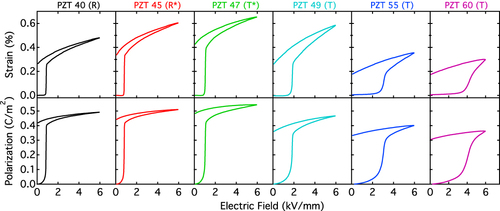
The remanent strain (εr), remanent polarization (Pr) and poling field (EP) were determined for each composition during electrical loading to 6 kV mm−1 (figure ). For comparison purposes, the lattice distortions are also included for tetragonal (δT) and rhombohedral (δR) compositions, determined by XRD [Citation22]. As expected, we find that the poling field is at a minimum near the MPB, interestingly on the rhombohedral side. The observed change in the poling field with PbTiO3 content corresponds well with previous measurements of the coercive stress [Citation22]. In the mechanical case, however, the minimum coercive stress was found for PZT 47 with an approximately linear increase with decreasing PbTiO3 content. Due to the significantly smaller lattice distortion of the rhombohedral phase, the reduced ferroelectric switching field does not result in enhanced remanent strain and polarization. In fact, the maximum remanent values were observed in PZT 47, which is on the tetragonal side of the MPB, where the poling field is similar to the rhombohedral phase but the lattice distortion is over three times larger. It is important to note here that the increase in remanent strain for PZT 47 corresponds to a grain size decrease of nearly 20% in comparison to PZT 40 (table ). With an increasing tetragonal distortion above PZT 45, an abrupt decrease in the remanent strain and polarization was found at PZT 49, followed by an apparent linear decrease in both values with further increasing PbTiO3 content.
Figure2 The remanent polarization, remanent strain, poling field and lattice distortion [Citation22] measured at room temperature during unipolar electric field loading as a function of PbTiO3 content. The maximum electric field applied was 6 kV mm−1. Open and filled symbols represent initially tetragonal and rhombohedral crystal structure, respectively.
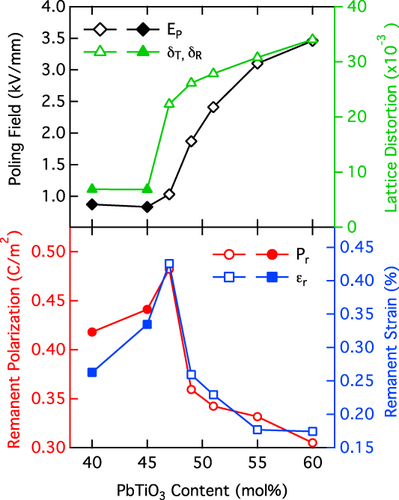
When the previous measured remanent strain values are normalized by their respective lattice distortions, i.e. switching strain, we find that the rhombohedral compositions display significantly larger values than those observed in tetragonal compositions (figure ), corresponding well with previous observations for mechanically loaded Pb(Zr1−xTix)O3 [Citation22]. In addition, experimental results for a maximum electric field of 2 kV mm−1 show the same trend as those performed to 6 kV mm−1. At the highest PbTiO3 content levels, however, it is found that 2 kV mm−1 was not large enough to produce remanent strain. This is due to the increase in the poling field for the tetragonal compositions with the highest lattice distortion. It is expected that with electric fields above 6 kV mm−1 the remanent strain of the tetragonal compositions would further increase. Unfortunately, due to the breakdown strength of these materials, higher electrical loads could not be applied.
Figure 3 Remanent strain/switching strain ratio for various Pb(Zr1−xTix)O3 compositions during unipolar electric field loading. The black dashed and blue dotted lines indicate the maximum theoretical remanent strain/switching strain ratio for ferroelectric switching in polycrystalline materials. Open and filled symbols represent initially tetragonal and rhombohedral crystal structure, respectively.
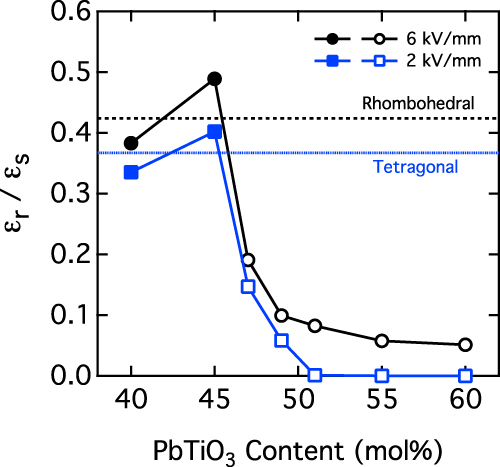
During the application of an external electric field on an unpoled ferroelectric material, the domains are expected to begin ferroelectrically reorienting when the applied field reaches a critical value [Citation40]. Typically, it is assumed that these switching events occur within a single phase, meaning that crystallites that are originally tetragonal remain so before, during, and after ferroelectric or ferroelastic switching [Citation40–Citation42]. In an ideal single phase polycrystalline ferroelectric material in the virgin state, the crystallographic orientations of all domains would be evenly distributed in all possible directions, referenced from a single global coordinate system. If the applied electric field is sufficiently large and all domains are allowed to reorient, i.e. there are not any barriers to ferroelectric switching such as local fields or defects, then we will find a distribution of polar axes in the direction of the applied field. Because the crystallographic orientations of each domain are defined in relation to the global coordinate system and cannot change during electrical loading, there is a theoretical maximum remanent strain-to-ferroelectric switching strain ratio (εr/εs) that can be attained for any single ferroelectric phase during electrical loading. For the case of rhombohedral and tetragonal, which are of interest here, these values are found to be 0.368 and 0.424, respectively [Citation38, Citation43, Citation44]. The difference between these two phases is due to the number of possible polarization directions; the tetragonal phase has six stable polarization directions, while the rhombohedral has eight. The additional stable polarization directions in the rhombohedral phase provide a larger statistical probability of domain alignment with the applied electric field direction. Interestingly, the εr/εs value for PZT 45, a rhombohedral composition, is approximately 17% larger than the theoretical maximum allowed by ferroelectric switching (dashed black line, figure ). This strongly indicates the presence of processes capable of resulting in plastic deformation, in addition to ferroelectric switching. All other compositions display values below their respective theoretical maximums, although rhombohedral PZT 40 is ∼90% of the theoretical value. This is particularly pronounced in the tetragonal compositions, which are between approximately 15 and 50% of the theoretical value.
These experimental observations can be explained by the presence of additional hysteretic processes that are activated by an electric field and are capable of producing plastic deformation. One such possibility would be the remanent changes in the lattice parameters without domain switching during the application of an external load. This has been experimentally observed in MPB compositions of Pb(Zr1−xTix)O3 during electrical [Citation36] and mechanical [Citation45] loading, which leads to the development of remanent strain in addition to that produced during domain reorientation. These microscopic changes are likely due to local stresses generated by strain mismatch between neighboring grains. During the electrical loading of rhombohedral Pb(Zr1−xTix)O3, for example, in situ XRD investigations have shown the development of tensile and compressive residual stresses parallel and perpendicular, respectively, to the poling direction [Citation46]. The changes in the lattice parameters due to the plastic deformation, however, are present in both tetragonal and rhombohedral compositions of Pb(Zr1−xTix)O3, whereas the large εr/εs ratios are only observed in compositions with rhombohedral symmetry. Previous temperature-dependent mechanical measurements have also revealed a significant decrease in the εr/εs ratio for originally rhombohedral compositions that crossed the MPB line, i.e. displayed tetragonal crystal structure, during heating [Citation22]. A second possible mechanism is the formation of an adaptive state near the MPB due to low domain wall energy densities, marked by a change from macroscopic lamellar tetragonal or herringbone rhombohedral domains to nanodomains [Citation10, Citation14]. The volume fraction of these nanodomains, along with their orientations, can be changed through the application of external stress [Citation11] or electric field [Citation47], which may lead to the development of additional macroscopic remanent strain, i.e. in addition to ferroelectric switching. It is, however, not currently clear how important nanodomain reorientation, formation or elimination during electrical loading is to the remanent strain. It has been proposed that the polarization of a microdomain will appear to rotate during electrical or mechanical loading due to the reorientation of nanodomains [Citation11], although it is unclear if this nanodomain reorientation is stable and, depending on the local crystal structure of the unit cell, whether it has an influence on the macroscopic remanent strain. Theissmann et al [Citation47], for example, has shown using in situ TEM studies that the nanodomain state reappears during electrical unloading, enhancing the piezoelectric properties near the MPB. An additional critical point is that nanodomains are found in both rhombohedral and tetragonal materials, indicating that the enhanced εr/εs ratio should be observed in both compositions, which is not the case.
Another possible origin for the extraordinary εr/εs ratio observed is the presence of electric-field-induced phase transitions. Such field-induced phase transitions have been extensively studied in single crystal ferroelectrics, specifically relaxor ferroelectrics [Citation48, Citation49]. It has been shown that both electrical and mechanical fields are capable of driving a phase transition, as evidenced by the macroscopic electrical and mechanical constitutive behavior [Citation50]. Due to the random grain orientations, however, it is difficult to clearly distinguish field-induced phase transitions in polycrystalline materials from the measurement of macroscopic behavior. Recent in situ synchrotron XRD [Citation35, Citation36] and neutron diffraction [Citation37] studies on Pb(Zr1−xTix)O3 have revealed that the application of an external electric field results in ferroelectric switching as well as phase transitions in the vicinity of the MPB. Field-induced phase transitions have also, for example, been observed in other polycrystalline ferroelectric materials with in situ diffraction techniques, such as (Bi1/2Na1/2)TiO3-based ferroelectrics [Citation51–Citation53], and have been suggested to be the origin of their large unipolar strain behavior.
Neutron diffraction measurements
To elucidate the effect of electric field on the phase stability of Pb(Zr1−xTix)O3, neutron diffraction was performed on PZT 40, 45 and 47 at room temperature. Diffraction patterns were obtained on each composition in the virgin state and in the unloaded, remanent state following an electrical loading with an amplitude of 2 kV mm−1. Diffraction patterns were collected for multiple sample orientations and combined so that the electric field is parallel to the scattering vector for all data points. Figure shows the entire pattern for each composition in the initial (black line) and remanent (red line) states. Experimental data clearly shows the presence of ferroelectricity in all compositions, shown by the changing intensities of the respective (200) and (111) peaks. In addition, the development of additional rhombohedral peaks can be observed in PZT 47, shown more clearly in figure , which was primarily tetragonal prior to electrical loading.
Figure 4 Neutron diffraction patterns for PZT 40, 45 and 47 in the initial virgin state (black line) and in the unloaded remanent state (red line) following electrical loading to 2 kV mm−1.
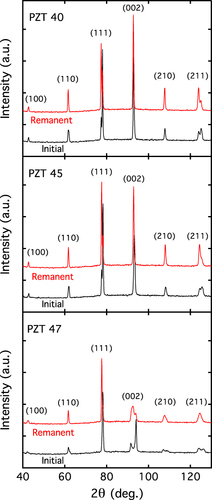
Figure 5 Neutron diffraction intensities of selected Bragg peaks for PZT 47, PZT 45 and PZT 40 in the virgin and remanent states. The patterns were collected with the scattering vector parallel to the applied electric field.

To investigate the change in crystal structure after electrical loading, the neutron diffraction intensities of the (111) and (002) Bragg peaks for PZT 47, PZT 45 and PZT 40 in the virgin and remanent states were examined, shown in figure . Here, (111) peak splitting was observed in the tetragonal composition (PZT 47) as well as the formation of an additional peak in the vicinity of the (002) Bragg peak position, representing a T → R phase transition as a result of electrical loading. A corresponding R → T phase transition was, however, not observed in the rhombohedral compositions (PZT 45 and PZT 40). PZT 45 and 40 show a change in the ratio of the relative intensity of each peak after electric field was applied, indicating domain switching. The single (002) peak position shifted toward a lower angle in the remanent state, which is due to a compliance strain. Due to intergranular coupling, strain induced by domain switching can influence surrounding grains [Citation54]. For rhombohedral phase materials, grains with (002) parallel to the field cannot strain due to domain switching, resulting in an elastic strain and a corresponding shift of the peak position. Initially, these results do not appear to support the observations from the macroscopic ferroelectric measurements (figure ); the largest εr/εs ratio was found in the rhombohedral materials. For this reason, it would be expected to also observe phase transitions in rhombohedral materials. To explain this discrepancy, a phenomenological model, capable of predicting field-induced phase transitions in ferroelectrics, is introduced. Simulations reveal that a relatively small volume fraction of material is required to undergo an R → T phase transition in order to produce a large effect and that these phase transitions occur at higher fields than the T → R transitions.
Phenomenological model
The field-induced phase transitions in single domain ferroelectrics can be described with the phenomenological Landau theory in terms of the order parameter polarization [Citation22, Citation23, Citation25]. The Devonshire form of the free energy density is given by
1
where α, γ and δ are the reciprocal dielectric susceptibility and the higher-order dielectric stiffnesses at constant electric field, P are the components of polarization, ε is the strain tensor, E is the applied electric field and q are the cubic electrostrictive coefficients [Citation55]. Although previous investigations have shown the necessity to include eighth order and higher terms in the Landau polynomial to describe lower symmetry phases, i.e. monoclinic and triclinic phases, and high temperature phase transition behavior [Citation56, Citation57], the truncated 2–4–6 Landau polynomial is used in this study. The 2–4–6 Landau polynomial is able to predict both the tetragonal and rhombohedral phases in the unloaded states as well as accurately predict temperature-dependent electric-field-induced phase transitions in single crystal BaTiO3 [Citation25]. Landau theory has also been applied to Pb(Zr1−xTix)O3 to predict the field-induced phase transition behavior during electrical [Citation23] and mechanical [Citation22] loading. Haun et al [Citation58] have provided approximations for the sixth order Landau coefficients for numerous Pb(Zr1−xTix)O3 compositions.
By implementing these coefficients in equation (Equation11 ) and minimizing the free energy function, the free energy landscape of single domain Pb(Zr1−xTix)O3 in all crystallographic orientations in response to an electric field can be shown (figure ). Coefficients for compositions between those presented by Haun et al [Citation58] were found by linear interpolation. Both the shape and the color indicate the free energy, with blue and red being the energetic minimum and maximum, respectively. In the stress-free state, it can be seen that PZT 40, PZT 45 and PZT 47 have global energetic minima along 〈111〉c crystallographic directions, while PZT 55 and PZT 60 have global energetic minima along 〈100〉c orientations, indicating rhombohedral and tetragonal phases, respectively. The globally stable rhombohedral phase and a metastable tetragonal phase were predicted for PZT 47, in contrast to structural investigations that revealed a majority tetragonal phase and a minority rhombohedral phase. This discrepancy could be due to the addition of dopants, which were absent in the materials presented by Haun et al [Citation58]. In addition, all simulated compositions also show metastable, local energetic minima in the polarization direction of the other phase. Two representative electric fields along the 〈100〉c and 〈111〉c directions are also shown. There is a distortion of the energy landscape along the crystallographic direction of the applied field. With an increasing field the local stable minima evolve toward the direction of the applied field. In the case of PZT 45 and PZT 47 with an applied electric field along the 〈100〉c-orientation, for example, it is shown that the energetic minima evolve from the 〈111〉c directions in the unloaded state to a single 〈100〉c direction, representing an electric-field-induced R → T phase transition. During unloading, assuming a lack of system perturbations, the polarization direction will remain in this locally stable direction, i.e. metastable direction. This minima evolution was also found for other rhombohedral and tetragonal compositions during electrical loading, signifying a corresponding R → T and T → R field induced phase transition, respectively.
Figure 6 Three-dimensional energy landscape for PZT 40, 45, 47, 55 and 60 in the unloaded state and with an applied electric field along the 100c and crystallographic orientations. The crystallographic axes areshown for the unloaded PZT 40 and apply to all figures.
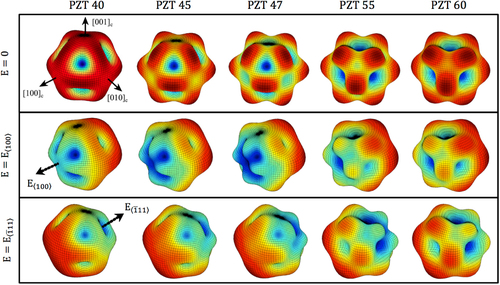
The distortion of the energy landscape is controlled by the chosen electrostrictive coefficients and their crystallographic dependence. The electrostrictive coefficients used during simulations were found by relating the spontaneous strain determined from XRD analysis [Citation22] and the spontaneous polarization in the stress-free state calculated using equation (1), as previously described in detail [Citation22]. Using this approach the cubic electrostrictive tensor could be predicted for both the rhombohedral and tetragonal phases in a single composition. It was found that the rhombohedral coefficients were significantly smaller, due to the reduced spontaneous strain. Due to the different electrostrictive coefficients in the rhombohedral and tetragonal phases, the effective electrostriction coefficients depend spatially on the evolution of the polarization during electrical loading and the instantaneous polarization value during simulations. During simulations, the effective electrostrictive coefficients for non-principle polarization directions were determined with the following function, which relates the instantaneous polar direction to the 〈111〉c crystallographic orientation
2
where δij is the Kronecker delta. The temporal evolution of the stable polarization direction can be determined by implementing equation (Equation1
1 ), accounting for the proper crystal symmetry, into the following Allen–Cahn-type evolution equation
3
and enforcing the following equilibrium equations:
4
where M is a fitting parameter describing the process mobility. Polycrystalline materials, such as those experimentally characterized in this study, are comprised of many randomly oriented single crystal grains. Using the previously described model for a single domain ferroelectric, the effective free energy of a polycrystalline system can be determined by integrating through Euclidean space
5
where f(ϕ), f(θ) and f(ψ) are distribution functions defined by the Euler angles ϕ, θ and ψ. Simulations were performed by numerically solving equation (Equation5
5 ) for 3 × 105 individual, non-interacting single domain grains, assuming the Ruess approximation. Each grain was assigned a unique Euler angle set (ϕ, θ, ψ) to ensure an even distribution of polar axes. During calculations, the mobility parameter M was chosen to be 2.5 × 10−9 A V−1 m−1 with a time step size of 1 × 10−3 s for all compositions. The electrical behavior of PZT 40, 45, 47 and 49 was simulated in response to an arbitrarily large electric field of 30 kV mm−1, which was chosen to ensure a saturated remanent state. The selected material properties are shown in table . The dielectric susceptibility and higher-order dielectric stiffness values were determined by linear interpolation from those presented by Haun et al [Citation58] for various compositions of PZT. The electrostrictive coefficients were calculated from the spontaneous strain, determined by XRD, and the spontaneous polarization, determined from the Landau coefficients. The method for calculating the electrostrictive coefficients is discussed in detail elsewhere [Citation22]. The phase in the virgin state for PZT 40 and 45 was assumed to be completely rhombohedral, while PZT 47, 49, 51, 55 and 60 were assumed to be completely tetragonal. The simulated εr/εs values as well as the trend with increasing PbTiO3 content were found to be in good agreement with experimental observations, as shown in figure . The simulated points represent the new theoretical maximum values when both ferroelectricity and field induced phase transitions are allowed during electrical loading.
Figure 7 Macroscopic remanent strain normalized by the microscopic switching strain (εr/εs) as a function of PbTiO3 content. Open and filled symbols represent initially tetragonal and rhombohedral crystal structure, respectively. The dotted blue and the dashed black horizontal lines indicate the maximum theoretical εr/εs value for the tetragonal and rhombohedral phases, assuming only ferroelasticity. Data points indicate the average measured value for each temperature and composition; error was estimated to be ±3%.
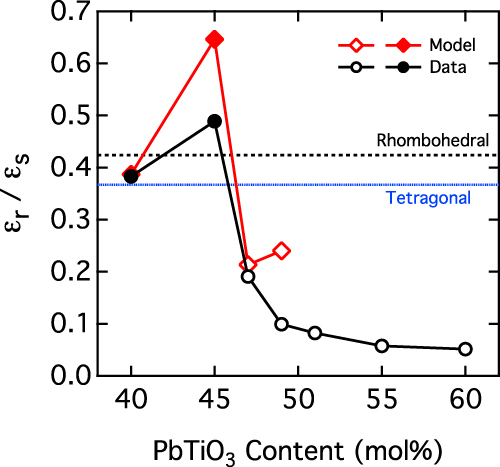
Table 2 The reciprocal dielectric susceptibility, higher-order dielectric stiffnesses and electrostrictive coefficients used for simulation of Pb(Zr1−xTix)O3 at 25 °C under an electric field.
The final simulated phase content is comprised of tetragonal and rhombohedral phase for all compositions, although the exact volume fraction of each depends on the Pb(Zr1−xTix)O3 composition, i.e. selected Landau and electrostrictive coefficients (figure ). One can see that the rhombohedral compositions (PZT 40 and 45) increased in tetragonal content by 5–20%, whereas the tetragonal compositions (PZT 47 and 49) increased in rhombohedral content by 80–68%. In contrast to previous investigations, no monoclinic phase was predicted during calculations [Citation22]. This was expected because in the unloaded state only the tetragonal and rhombohedral phases are stable. Results from figure clearly illustrate the difference in the R → T and T → R energetic thresholds; R → T transitions were less favorable. This is due to the smaller electrostrictive coefficients of the rhombohedral phase, which result in a lower energy state during loading, i.e. global stability. This is also the origin of the enhanced εr/εs value in rhombohedral materials. Despite the unfavorable nature of the R → T transition in rhombohedral materials, their occurrence, due to the significantly larger spontaneous strain of the tetragonal phase, results in a marked increase in the εr/εs ratio. The remanent strain is a composite value with contributions from both the rhombohedral and tetragonal phases that is then normalized by the rhombohedral spontaneous strain, making it appear artificially large. The reverse is found in tetragonal compositions; T → R phase transitions decrease the composite remanent strain value, which is then normalized by a larger spontaneous strain value.
Initially, the diffraction measurements appear counterintuitive; clear evidence of an electric-field-induced phase transition was only found in the tetragonal composition. However, as can be clearly observed in figure , such field-induced phase transitions are expected to occur at a much lower rate in rhombohedral materials compared to tetragonal materials, making their observation with diffraction techniques more difficult. Simulations were performed for the ideal case, assuming no grain-to-grain interactions and ideal saturation. Diffraction experiments, however, were only performed to approximately two times the coercive field, which likely did not result in a fully saturated state and was not large enough to generate a measurable volume fraction of material that underwent an R → T phase transition in PZT 40 and PZT 45. In PZT 40, for example, calculations predict a maximum theoretical change in phase content of 5 vol% for a simulated electric field of nearly 30 times the coercive field. It is expected that reducing the maximum applied electric field will significantly decrease the volume fraction of material undergoing a phase transition below the resolution limit of the diffraction analysis. In addition, these calculations do not take other remanent strain mechanisms into account, such as residual elastic strains originating from grain-to-grain interactions, that can also contribute to the observed macroscopic remanent strain.
Summary
The macroscopic strain and polarization during unipolar electric field loading was characterized for various compositions of Pb(Zr1−xTix)O3 across the MPB. Samples were initially in the virgin state, allowing for the determination of the remanent strain as a function of PbTiO3 content. Combining these results with the switching strain determined by XRD showed that the observed remanent strain was larger than theoretically possible, when only ferroelectric switching was considered. A free energy analysis was used to determine the effect of phase transitions on the remanent strain during electrical loading. The predicted remanent-to-switching strain values display a trend in good agreement with experimental measurements, providing an indication of field induced phase transitions in Pb(Zr1−xTix)O3 ceramics.
Acknowledgments
AB, JK and BM would like to acknowledge financial support from the European Union under the Seventh Framework project HIgh-PERformance Piezoelectric Actuators (HIPER-Act). DJF acknowledges financial support from the Graduate School of Computational Engineering. YHS would like to acknowledge financial support from the Leibniz programme of the Deutsche Forschungsgemeinschaft under RO 954/22. JG acknowledges financial support from the Australian Research Council (grant number DE120102644). JED acknowledges financial support of an AINSE Research Fellowship and ARD DP120103968. KGW gratefully acknowledges the support of the Deutsche Forschungsgemeinschaft under WE4972/1-1.
References
- RandallC AKelnbergerAYangG YEitelR EShroutT R 2005 J. Electroceram. 14 177 10.1007/s10832-005-0956-5
- MoffettM BRobinsonH CPowersJ MBairdP D 2007 J. Acoust. Soc. Am. 121 2591 10.1121/1.2717496
- JaffeBCookW RJaffeH 1971 Piezoelectric Ceramics London Academic
- KunglHHoffmannM J 2007 Acta Mater. 55 5780 10.1016/j.actamat.2007.06.035
- LynchC S 1996 Acta Mater. 44 4137 10.1016/S1359-6454(96)00062-6
- DamjanovicDDemartinM 1997 J. Phys.: Condens. Matter 9 4943 10.1088/0953-8984/9/23/018
- MichelCMoreauJ MAchenbacG DGersonRJamesW J 1969 Solid State Commun. 7 865 10.1016/0038-1098(69)90429-3
- CaoW WCrossL E 1993 Phys. Rev. B 47 4825 10.1103/PhysRevB.47.4825
- GuoRCrossL EParkS ENohedaBCoxD EShiraneG 2000 Phys. Rev. Lett. 84 5423 10.1103/PhysRevLett.84.5423
- SchoenauK ASchmittL AKnappMFuessHEichelR-AKunglHHoffmannM J 2007 Phys. Rev. B 75 184117 10.1103/PhysRevB.75.184117
- JinY MWangY UKhachaturyanA GLiJ FViehlandD 2003 J. Appl. Phys. 94 3629 10.1063/1.1599632
- NohedaBCoxD EShiraneGGonzaloJ ACrossL EParkS E 1999 Appl. Phys. Lett. 74 2059 10.1063/1.123756
- CorkerD LGlazerA MWhatmoreR WStallardAFauthF 1998 J. Phys.: Condens. Matter 10 6251 10.1088/0953-8984/10/28/007
- SchmittL ASchoönauK ATheissmannRFuessHKunglHHoffmannM J 2007 J. Appl. Phys. 101 074107 10.1063/1.2715476
- HeitmannA ARossettiG AJr 2010 Phil. Mag. 90 71 10.1080/14786430902897750
- HongSCollaE LKimETaylorD VTagantsevA KMuraltPNoKSetterN 1999 J. Appl. Phys. 86 607 10.1063/1.370774
- DuikerH MBealeP D 1990 Phys. Rev. B 41 490 10.1103/PhysRevB.41.490
- HaertlingG H 1999 J. Am. Ceram. Soc. 82 797 10.1111/j.1151-2916.1999.tb01840.x
- DamjanovicD 1997 J. Appl. Phys. 82 1788 10.1063/1.365981
- KunglHTheissmannRKnappMBaehtzCFuessHWagnerSFettTHoffmannM J 2007 Acta Mater. 55 1849 10.1016/j.actamat.2006.10.046
- YamamotoT 1996 Japan. J. Appl. Phys. 35 (Pt 1) 5104 10.1143/JJAP.35.5104
- SeoY-HFranzbachD JKoruzaJBenčanAMaličBKosecMJonesJ LWebberK G 2013 Phys. Rev. B 87 094116 10.1103/PhysRevB.87.094116
- BellA J 2000 Appl. Phys. Lett. 76 109 10.1063/1.125672
- BellA J 2001 J. Appl. Phys. 89 3907 10.1063/1.1352682
- FranzbachD JGuY JChenL QWebberK G 2012 Appl. Phys. Lett. 101 232904 10.1063/1.4769368
- HaeniJ H 2004 Nature 430 758 10.1038/nature02773
- PertsevN AZembilgotovA GTagantsevA K 1998 Phys. Rev. Lett. 80 1988 10.1103/PhysRevLett.80.1988
- ZechesR J 2009 Science 326 977 10.1126/science.1177046
- SamaraG A 1966 Phys. Rev. 151 378 10.1103/PhysRev.151.378
- ForsberghP WJr 1953 Phys. Rev. 93 686 10.1103/PhysRev.93.686
- MerzW J 1950 Phys. Rev. 78 52 10.1103/PhysRev.78.52
- PichtGWebberK GZhangYKunglHDamjanovicDHoffmannM J 2012 J. Appl. Phys. 112 124101 10.1063/1.4767059
- WebberK GZhangYJoWDanielsJ ERödelJ 2010 J. Appl. Phys. 108 014101 10.1063/1.3428373
- GonzaloJ ARiveraJ M 1971 Ferroelectrics 2 31 10.1080/00150197108243942
- HintersteinMRouquetteJHainesJPapetPKnappMGlaumJFuessH 2011 Phys. Rev. Lett. 107 077602 10.1103/PhysRevLett.107.077602
- SchoenauK AKnappMKunglHHoffmannM JFuessH 2007 Phys. Rev. B 76 144112 10.1103/PhysRevB.76.144112
- HintersteinMHoelzelMKunglHHoffmannM JEhrenbergHFuessH 2011 Z. Kristallogr. 226 155 10.1524/zkri.2011.1338
- UchidaNIkedaT 1967 Japan. J. Appl. Phys. 6 1079 10.1143/JJAP.6.1079
- StuderA JHagenM ENoakesT J 2006 Physica B 385–386 1013 10.1016/j.physb.2006.05.323
- HwangS CLynchC SMcMeekingR M 1995 Acta Metall. Mater. 43 2073
- HuberJ EFleckN ALandisC MMcMeekingR M 1999 J. Mech. Phys. Solids 47 1663 10.1016/S0022-5096(98)00122-7
- LuWFangD NLiC QHwangK C 1999 Acta Mater. 47 2913 10.1016/S1359-6454(99)00153-6
- JonesJ LHoffmanMBowmanK J 2005 J. Appl. Phys. 98 024115 10.1063/1.1988978
- LiF XRajapakseR 2007 J. Appl. Phys. 101 054110 10.1063/1.2645889
- JonesJ LHoffmanMVogelS C 2007 Mech. Mater. 39 283 10.1016/j.mechmat.2006.06.005
- HallD ASteuwerACherdhirunkornBMoriTWithersP J 2006 Acta Mater. 54 3075 10.1016/j.actamat.2006.02.043
- TheissmannRSchmittL AKlingJSchierholzRSchoenauK AFuessHKnappMKunglHHoffmannM J 2007 J. Appl. Phys. 102 024111
- ParkS EShroutT R 1997 J. Appl. Phys. 82 1804 10.1063/1.365983
- WadaSSuzukiSNomaTSuzukiTOsadaMKakihanaMParkS ECrossL EShroutT R 1999 Japan. J. Appl. Phys. 38 (Pt 1) 5505 10.1143/JJAP.38.5505
- DavisMDamjanovicDSetterN 2006 Phys. Rev. B 73 014115 10.1103/PhysRevB.73.014115
- DanielsJ EJoWRödelJJonesJ L 2009 Appl. Phys. Lett. 95 032904 10.1063/1.3182679
- JoWDanielsJ EJonesJ LXiaoliTThomasP ADamjanovicDRoumldelJ 2011 J. Appl. Phys. 109 014110 10.1063/1.3530737
- HintersteinMKnappMHoelzelMJoWCervellinoAEhrenbergHFuessH 2010 J. Appl. Crystallogr. 43 1314 10.1107/S0021889810038264
- PramanickAPrewittA DCottrellM ALeeWStuderA JAnKHubbardC RJonesJ L 2010 Appl. Phys. A 99 557 10.1007/s00339-010-5605-4
- DevonshireA F 1949 Philos. Mag. 40 1040
- WangY LTagantsevA KDamjanovicDSetterNYarmarkinV KSokolovA ILukyanchukI A 2007 J. Appl. Phys. 101 104115 10.1063/1.2733744
- VanderbiltDCohenM H 2001 Phys. Rev. B 63 094108 10.1103/PhysRevB.63.094108
- HaunM JZhuangZ QFurmanEJangS JCrossL E 1989 Ferroelectrics 99 45 10.1080/00150198908221438

